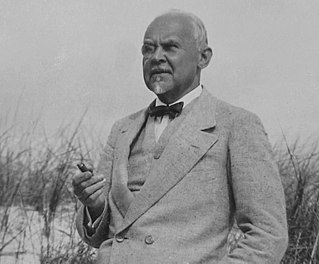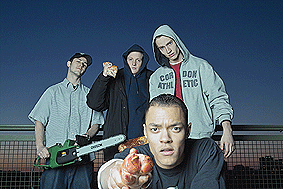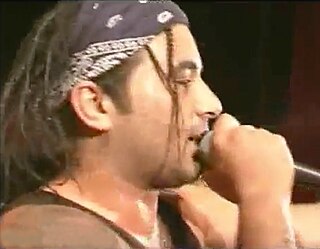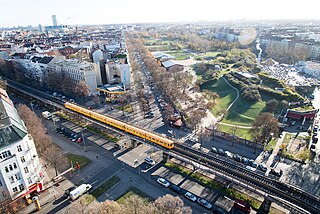
Konrad Zuse was a German civil engineer, pioneering computer scientist, inventor and businessman. His greatest achievement was the world's first programmable computer; the functional program-controlled Turing-complete Z3 became operational in May 1941. Thanks to this machine and its predecessors, Zuse has often been regarded as the inventor of the modern computer.

Kreuzberg, is a district of Berlin, Germany. It is part of the Friedrichshain-Kreuzberg borough located south of Mitte. During the Cold War era, it was one of the poorest areas of West Berlin, but since German reunification in 1990 it has become more gentrified and known for its arts scene.

Owing to labour migration in the 1960s and several waves of political refugees since the 1970s, Islam has become a visible religion in Germany. An estimate published in 2016 for 2015 calculated that there are 4.4 to 4.7 million Muslims in Germany. Of these, 1.9 million are German citizens (2.4%). There are also higher estimates, for example according to the German Islam Conference in 2012, Muslims represent 7% of the population in Germany in 2012. According to a 2019 statistical count, there are nearly 440,000 individuals from countries with a muslim majority in Berlin, constituting 11.6% of the population.

Alfred Frederik Elias Grenander was a Swedish architect, who became one of the most prominent engineers during the first building period of the Berlin U-Bahn network in the early twentieth century.

Paul Hartmut Würdig, better known as Sido, is a German rapper. He interprets his artist name as "super-intelligentes Drogenopfer". It used to stand for "Scheiße in dein Ohr", a line from his track Terroarr. Sido is currently signed to Urban/Universal Music Group.

Anis Mohamed Youssef Ferchichi, better known by his alias Bushido, is a German rapper, hip-hop producer, and entrepreneur of Tunisian descent. He is the co-founder of the record label ersguterjunge. Born in Bonn and raised by a single mother in Berlin-Tempelhof, Ferchichi came in contact with hip-hop through graffiti and his friend and fellow rapper Fler. In 2001, Ferchichi released his demo King of KingZ, which later led him to sign a record label deal with Aggro Berlin. Ferchichi's first official release was Carlo Cokxxx Nutten in 2002, a collobaration with Fler.

Paradestraße is a Berlin U-Bahn station on the line. It was opened in 1927 as Flughafen (airport) and at that time provided the world's first direct connection between a metro system and an airport.

K.I.Z is a German hip hop group from Berlin. The members are the three rappers Tarek, Nico and Maxim. Until 2018, DJ Craft was also part of the group. Their lyrics often contain a lot of black humor and irony as well as sociocritical content.
Neco Çelik is a Turkish-German filmmaker.

Jerusalem Church is one of the churches of the Evangelical Congregation in the Friedrichstadt, a member of the Protestant umbrella organisation Evangelical Church of Berlin-Brandenburg-Silesian Upper Lusatia. The present church building is located in Berlin, borough Friedrichshain-Kreuzberg, in the quarter of Friedrichstadt. Jerusalem Church is fourth in rank of the oldest oratories in the town proper.

The Fichte-Bunker is a nineteenth-century gasometer in the Kreuzberg district of Berlin, Germany that was made into an air-raid shelter in World War II and subsequently was used as a shelter for the homeless and for refugees, in particular for those fleeing East Berlin for the West. It is the last remaining brick gasometer in Berlin.

Azad Azadpour is a German rapper of Kurdish descent based in Frankfurt am Main. As one of the first German street rappers who become successful, he strongly influences the German rap scene.

Berlin is recognized as a world city of culture and creative industries. Numerous cultural institutions, many of which enjoy international reputation are representing the diverse heritage of the city. Many young people, cultural entrepreneurs and international artists continue to settle in the city. Berlin has established itself as a popular entertainment center in Europe.

Hakan Durmuş, better known by his stage name Killa Hakan, is a Turkish rapper and songwriter who lives in Germany.

Görlitzer Park is a major park and recreation area in the Kreuzberg district of Berlin. The 14-hectare park area contains, among other things, a petting zoo, several sports and football fields, and a small lake. At its north-west end is the Görlitzer Bahnhof U-Bahn station.

The FHXB Friedrichshain-Kreuzberg Museum is a local history museum focusing on the borough of Friedrichshain-Kreuzberg in Berlin, Germany. It contains a historical archive related to both parts of the district, permanent exhibits on urban development and social and immigration history, temporary exhibits on the district's past and present, and a historic printing press. The museum is part of the Culture and History Department within the district administration of Friedrichshain-Kreuzberg, and is located at Adalbertstrasse 95a in Kreuzberg.

Ufuk Bayraktar, better known by his stage name Ufo361, is a German rapper of Turkish descent from Berlin.

SXTN was a German hip hop duo from Berlin consisting of rappers Juju and Nura. They are known for their somewhat-mockingly provocative lyrics, that often play on stereotypical rap themes such as sex, weed-smoking, money and party lifestyles.
Vera Friedländer was a German writer and Holocaust survivor.

The synagogue on Fraenkelufer in Berlin's Kreuzberg district was built as an Orthodox Synagogue between 1913 and 1916 according to plans and under the direction of the master builder of the Jewish Community of Berlin, Alexander Beer. The structure was located on Kottbusser Ufer 48–50, today's Fraenkelufer 10-16. On Kristallnacht, the evening of November 9-10th, 1938, the main building of the synagogue was badly damaged. Further destruction in the following years led to the structures ultimate demolition in 1958/1959 after the end of World War II. Today the surviving outbuilding, previously used for the youth service, has been renovated and is home to a Conservative Synagogue. A complete reconstruction of the main synagogue that was destroyed by the National Socialists is being planned for its original location.



















